California
Department of Forestry and Fire Protection
Review Report of Serious CDF Injuries, Illnesses, Accidents
and Near-Miss Incidents
Engine Crew Entrapment, Fatality, and Burn Injuries
October 29, 2003
Cedar Fire
CACNF-003056
CACSR-000132
Southern Region
SEQUENCE OF EVENTS
On October 28, 2003, Battalion Chief John Michelini is assigned as the
Structure Group Supervisor for the Julian Structure Group. According to
Michelini, throughout the day, units are deployed in and around structures
south of Highway 78/79. He observes that at about 5:00 p.m., the fire’s
northern spread has been stopped between Pine Hills Road and Wynola. Open
line continues to burn between Wynola Estates and Santa Ysabel below Highway
78/79. [1] By late afternoon, the
Cedar Fire, under an onshore wind influence has burned northeast up the
San Diego River drainage to just southwest of Highway 78/79.
At about 6:00 p.m., Branch III Director Randy Lyle advises Structure
Group Supervisor Michelini that the Command Team wants a black line to
be brought down from Pine Hills Road to Santa Ysabel along Highway 78/79.
His objective is to fire-out around structures, burn-out islands, and
create a control line along Highway 78/79, from Pine Hills Road to Santa
Ysabel, a distance of approximately seven miles. Based on this request,
Michelini initiates a firing-out operation, which takes most of the night.
[1]
Strike Team (S/T) Leader Thomas Keating with S/T XST 4205A is assigned
the firing-out operation by Structure Group Supervisor Michelini. Michelini
tells Keating that the fire is moving towards the Inaja Memorial and that
he needs to go “fire-out the canyon so that the fire does not cross
Highway 78/79.” When S/T Leader Keating arrives at his assignment
at Riverwood Road and the Inaja Memorial, he “(feels) uncomfortable
with the order to back-fire the canyon.” [2]
S/T Leader Keating notes that the fire is already at the bottom of the
canyon but has not burned clean. He requests that Michelini come to his
location and confirm what he wants before they put fire on the ground.
While waiting for Michelini, Keating is joined by S/T Leader Allen Chandler
and Strike Team 1624C. This is a mixed strike team mostly of U.S. Forest
Service engines. S/T Leader Chandler tells Keating that he also has concerns
about burning out this area.
Keating discusses the situation with Structure Group Supervisor Michelini,
and he and S/T Leader Chandler decide they can safely fire this area out.
The firing operation in the area of Highway 78/79 and Riverwood Road begins
at about 1:00 a.m. on October 29. Keating observes that the burning-out
operation between Riverwood Road and the Inaja Memorial goes well and
the fire burns all the way to the bottom of the canyon. [2]
The firing operation follows Riverwood Road and progresses to where it
returns to Highway 78/79 on the west side of the San Diego River. This
action leaves an unburned island of fuel between Riverwood Road and Highway
78/79 near the bottom of the San Diego River drainage. The firing then
progresses from the Inaja Memorial back towards Riverwood Road, completing
this section at about 6:00 a.m. Structure Group Supervisor Michelini notes
that all firing-out is completed by 6:00 a.m. with the exception of the
area from the Inaja Memorial to Santa Ysabel. [1]
S/T Leader Watkins (XAL 2005A) attends the morning briefing at 7:00 a.m.
in camp. The Incident Action Plans (IAP) are late in printing and only
show up midway through the briefing. Incident Commander John Hawkins and
Planning Section Chief Ed Kilmartin conduct the briefing. After roll call,
Watkins is told that S/T 2005A is assigned to Branch III, Division I.
Chief Hawkins identifies for Watkins the location where he can meet with
Division I. [3]
S/T Leader Watkins meets with Division I, Dan Runnestrand, and is given
a brief overview of their assignment. He and his strike team are to meet
Runnestrand at Santa Ysabel as soon as possible. Watkins returns to his
strike team to find them fully prepared and ready to move out. He conducts
a briefing with the strike team, tells them of the assignment and passes
on safety information. At about this time, additional King radios have
come into the communications unit and the strike team spends time obtaining
and re-cloning radios. [3]
According to Michelini he is contacted by S/T Leader Chandler, USFS S/T
1624C, by 7:00 a.m. and he advises him that they have initiated firing-out
from the Inaja Memorial towards Santa Ysabel but have extinguished the
firing operation due to unsettled conditions. [1]
S/T Leader Keating observes that after about twenty minutes of firing
out, S/T Leader Chandler calls a halt to the firing operation. Keating
notes that there has been a wind change and the fire is coming out of
the canyon faster than they had anticipated. His strike team then leaves
the area to seek mechanical repairs. [2]
Branch Director Ray Chaney meets with Deputy Branch III at Santa Ysabel
at about 8:15 a.m. and observes the fire bumping Highway 78/79, near the
Inaja Memorial. They advise CHP to close traffic to the area.4 By the
time Structure Group Supervisor Michelini arrives at the firing-out operation
on Highway 78/79, between the Inaja Memorial and Santa Ysabel, S/T 1624C
with S/T Leader Chandler and S/T 4205A with S/T Leader Keating, have completely
knocked down the back fire and are cleaning up the area. [1]
Chandler later tells Keating that after he has left the scene for repairs,
the fire “blow(s) over his crew and Highway 78/79. [2]
Air Tactical Group Supervisor Ray Sauceda is assigned to Branch III of
the Cedar Fire along with three fixed wing air tankers. He is on scene
at about 8:30 a.m. He makes a request for helicopters to support ground
operations, and then determines that he cannot communicate with the ground
resources. This leads him to believe that the communications plan is not
in effect with all the resources. He then orders the helicopters to hold
on base and tells the fixed wing to return to base until Branch III can
confirm they have communications. All air assets return to base. [5]
Sauceda’s understanding of the communications problem was “that
crews on the ground thought that they were using yesterday’s Com
Plan.” Crews on the ground at that time were still there from the
previous days’ shift and were using the October 28 IAP; however
according to Sauceda, the IAP for October 29 clearly shows a change. [5]
Review of the IAPs for October 28 and 29, indicates that the only change
in the communications plan was in the Command Net (Air-to-Ground and Branch
III Tactical nets were the same)]. [109]
Between 9:00 a.m. and 9:15 a.m., the main fire crosses Highway 78/79 just
west of the Inaja Memorial. Both S/T Leader Chandler and Structure Group
Supervisor Michelini note that the firing operations are all secure prior
to this event and that the fire that spots across the Highway is a run
of the main fire. Chandler says that the fire spots into light grass on
the east side of the Highway and immediately starts running up the ridge.
He commits his entire strike team to pick up the fire on the east side,
but due to erratic fire behavior they have to leave the line. [6]
At about 9:00 a.m. on October 29, the backing fire (main fire) is well
established across the draw below Highway 78/79 and spreads rapidly up
the slope out of the drainage and across Highway 78/79. Structure Group
Supervisor Michelini briefs his relief who is Division I, Dan Runnestrand,
along with the incoming Branch III Director, Ray Chaney. He then goes
to Ramona. [1]
Division I Runnestrand is briefed by the night shift and afterwards makes
plans to find an anchor point and use bulldozers to work the west flank
of the “slop-over” that has crossed Highway 78/79. At this
time he describes the “slop-over” as running north high on
the west ridge above the San Diego River. He observes the wind is out
of the south-southeast, at about five to seven mph. [7]
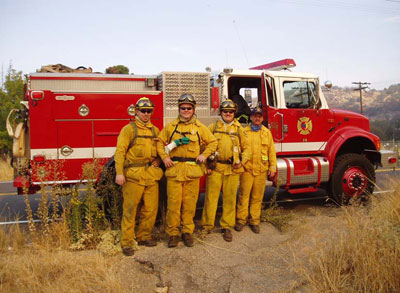
Engine 6162 crew at Santa Ysabel on the morning of Oct. 29, 2003; Left
to right: Firefighter Barrett Smith, Engineer Shawn Kreps, Engineer
Steve Rucker and Captain Doug McDonald.
Strike Team 2005A with Engine 6162 which is assigned to Branch III, Division
I, arrives at Santa Ysabel at about 9:15 a.m. [8]
At first, Strike Team Leader Jim Watkins cannot find anyone from Division
I.
Division I Runnestrand, who has been busy talking about a bulldozer operation
finally arrives, and he and S/T Leader Watkins talk again. Runnestrand
gives Watkins a “pretty good briefing on the fire activity the day
before, what was goin’ on, what to expect.” [9]
Branch III Director Chaney meets with Division I Runnestrand at about
9:30 a.m. and instructs him to start a direct attack on the fire that
has crossed Highway 78/79. After re-evaluating, Chaney directs Division
I to move resources to the right or southern flank, establish an anchor
point and go direct with suppression efforts heading east in a flanking
action to keep the fire from moving south towards Julian. [4]
Also present during the briefing is CDF Fire Captain (FC) John Childe
and CDF Fire Apparatus Engineer (FAE) Isaac Sanchez. FC Childe offers
up his assistance to do some scouting for Branch III Chaney.10 FC Childe
tells Chaney that he is going to conduct some scouting in the Schoolhouse
Road area. [11]
Deputy Branch III, Mike Wakoski, also speaks with FC Childe during this
briefing. FC Childe introduces himself to Wakoski as the leader of a firing
team. According to Wakoski, FC Childe also tells him that he is a liaison
between the Paradise Fire and the Cedar Fire. [12]
S/T Leader Watkins notices during the briefing a CDF Fire Captain, (later
identified as FC Childe [13])
who “interject(s) rather enthusiastically about doing some burning
operations around the dozer… he (is) trying to convince the Division
I Supervisor that you need to start puttin’ some fire on the ground.”
S/T Leader Watkins says that the Fire Captain is “pretty aggressive
about it.” Watkins thinks the Fire Captain is badgering the Division
Supervisor who has listened to Childe, and is tired of it. Watkins says
that the Fire Captain is not budging off his position even though the
Division Supervisor has incorporated some of his suggestions into the
plan. [14]
Division I Runnestrand states that during the briefing, FC Childe “(has)
lots of ideas on how I should fight this fire, and, you know, which is
not atypical when you have somebody that’s just out freelancing,
lots of ideas.” During this conversation, according to Runnestrand,
FC Childe makes it clear that he does not work for Division I and is not
assigned to the division. [15]
FC Childe then leaves that location and conducts scouting in the Schoolhouse
Road area where he runs into the leader of a U. S. Forest Service hand
crew. [11]
According to rough estimates by Division I Runnestrand, and Pilot Hunter
Ridenour, (Tactical map by Runnestrand in evidence, and drawing by Pilot
Hunter Ridenour in Tab Section 57 of Attachments) by late morning the
fire has crossed Highway 78/79 and is burning in a northern direction
up the ridge on the west side of the San Diego River drainage. The fire
has spread along this ridge about one half to three-quarters of a mile
past Highway 78/79. The fire is making short runs in the grass, brush
and oak trees in the area during the late morning.
Between 9:00 a.m. and 10:00 a.m., Air Tactical Group Supervisor Ray Sauceda
returns to Branch III after clearing up the communications plan with Branch
III. It is agreed that helicopter support can be called for down to the
Division Supervisor level, unless it is an emergency. [5]
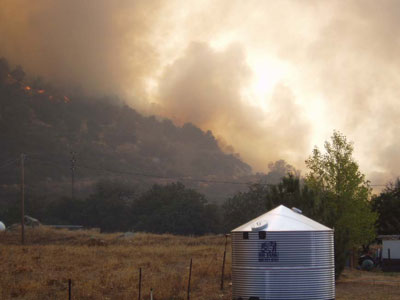
Slop-over Fire after it crossed Highway 78/79; viewed from Santa Ysabel
by the crew of Engine 6162. Photo taken by Firefighter-Paramedic Barrett
Smith at 9:47 a.m. on 10/29/03.
At 9:47 a.m., S/T 2005A with Novato Engine 6162 observes the fire that
has crossed Highway 78/79 between Santa Isabel and the Inaja Memorial.
(See photo above) By about 10:20 a.m., S/T 2005A is assigned to do structure
protection in the Riverwood Estates. At 10:22 a.m., Firefighter-Paramedic
Smith on Engine 6162 takes photos as they drive through the slop-over
area. (See photo next page)
When Firefighter-Paramedic Smith [16]
and Engineer Kreps [17], arrive
in the Riverwood Estates, the find that the area around the structures
has been fired-out and begin mop-up operations. Both watch as the fire
burns to the west in the distance where the fire has jumped the highway
and is now northwest of Highway 78/79. The fire is calm in the Riverwood
Estates area.
While the crew of Engine 6162 is doing structure protection in the Riverwood
Estates, Captain McDonald has a discussion with members of the crew, including
Engineer Rucker, concerning the use of hose packs. Captain McDonald states
that if there is a need to protect the structure, they will extend the
deployed hose lines with the first 100 feet of a 200 foot wildland hose
pack.94 According to the apparatus inventory, these packs are located
in the rear compartment of Engine 6162.
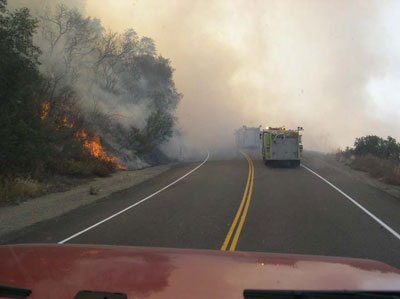
Engine 6162 driving through the slop-over area on Highway 78/79.
From his location in the Riverwood Estates, S/T Leader Watkins can see
the fire burning on the other side of Highway 78/79. He describes the
fire across the highway as being pushed along the hill slowly by the wind.
He also describes the smoke column, at about 1,000 feet, as having the
top going back over them to the east. [9]
Captain Michael Carpenter on Engine 24 of S/T 2005A and his crew are
assigned by S/T Leader Watkins to protect a house on the east side of
Highway 78/79, about one quarter mile north of its junction with Riverwood
Road. They arrive at this location and while preparing the house, watch
the fire across Highway 78/79 as it backs down the ridge towards the Highway.
This house is located in the unburned island between Riverwood Road and
Highway 78/79. [18]
S/T Leader Watkins deploys his strike team and then meets up with S/T
2004A who have shown up at their location. S/T 2004A cannot find the Division
Supervisor so Watkins has them join in doing structure protection. Watkins
attempts but is unable to contact Division I by radio and inform him.
Shortly after this, S/T 1286A also arrives. [19]
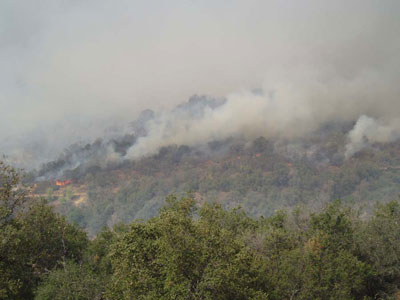
Looking west from Riverwood Estates towards the slop-over above Highway
78/79 at 10:56 a.m. on October 29, 2003. Photo taken by Firefighter-Paramedic
Barrett Smith.
Deputy Branch III Mike Wakoski meets with Division I Runnestrand, at
about 11:00 a.m. to reallocate resources in an effort to cut-off the spread
of the slop-over towards Wynola and Julian. [20]
Plans are made to use bulldozers to build fire line around the fire on
the north side of the highway. Bulldozers that were deployed to the west
flank are moved towards the east flank. S/T Leader Watkins goes to recon
the area and finds Division I Runnestrand, out on Highway 78/79 along
with another staff member (believed to be Deputy Branch III). Watkins
advises Runnestrand about the presence of S/T 2004A. Runnestrand says
that he has been trying to raise them on the radio. During this meeting,
Runnestrand tells Watkins that he needs them to move to Orchard Lane.
[3]
Several helicopters, including 523 EH piloted by Hunter Ridenour, arrive
about 11:35 a.m. and start making bucket drops along a dirt road on the
east side of the San Diego River (dry at this time) just to the north
of where Highway 78/79 crosses the river. The objective of this action
is to try to keep the fire on the west side of the San Diego River drainage
and away from structures in the area. [21]
Instructions from the Air Tactical Group Supervisor are for them to choose
their own drop points with priority to protect structures. Pilot Ridenour
observes the wind at that location to be “strong out of the southwest
up the draw and onto the ridge to the east.” [5]
Ron Mitchell, a resident at 1126 Orchard Lane, has stayed at his home
to protect it from the fire on the morning of October 29th. He observes
the fire from a lookout point on the west side of his property. Mitchell
sees the fire burning on the west ridge across the canyon from his residence.
He describes the wind as being out of the south and the fire spread to
the north. Mitchell describes the fire as not burning very fast and he
observes the flames going straight up. The smoke column is going up and
then blowing to the northeast along the ridge. He estimates the fire (early
on) is not yet below the mid-point of the ridge but is burning slowly
towards the bottom of the canyon. There is blue sky above him with only
a little wind at his home. He observes that the leaves in the trees are
barely moving. [22]
During this time, the fire on the west side of the drainage has moved
up-canyon and gained elevation. Coming under the influence of a west wind
running perpendicular to the ridge top, the fire higher in the drainage
spreads to the northeast. Burning to and past the northeast corner of
the property located at 902 Orchard Lane and leaving spot fires near the
southeast flank. The fire has now established itself on the eastern side
of the drainage in a hooking move to the northeast.
Mr. Mitchell, still at his residence on Orchard Lane, observes that at
about noontime the winds start to change and are coming directly out of
the west. He sees the fire move down into the canyon bottom from the west
ridge and “start(ed) shooting up” to the north of his location.
[22]
S/T 2005A is grouped up again to begin its move towards the Orchard Lane
area. Engine 24, still at the house about one quarter mile north of Riverwood
Road on Highway 78/79, observes that the fire has almost burned down to
the highway. At this time, the strike team drives by and Engine 24 falls
into line behind them. [3] Engine
334 goes to a hydrant to top off its tank.
At about 11:45 a.m. S/T Leader Watkins drives north on Orchard Lane [23]
while S/T 2005A is staged at the intersection of Orchard Lane and Highway
78/79. Active fire behavior is observed to the north end of Orchard Lane.
As he drives up Orchard Lane, the S/T Leader for 2005A realizes that it
is a long road and he calls back for the strike team to start moving up.
S/T Leader Watkins can see the fire coming and knows that time is short.
[24]
Prior to 11:50 a.m. and during an approach to the area in the bottom
of the canyon near Highway 78/79, the pilot of helicopter 523 EH Hunter
Ridenour, observes spot fires burning near the northeast corner of the
structure at 902 Orchard Lane. The pilot calls air attack and informs
him of the spot fires. The helicopter operation is then moved to the ridge
on the east side of the drainage where residences on Orchard Lane are
being threatened by a flanking fire. [21]
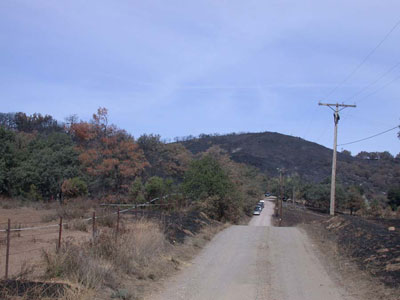
Post fire view of Orchard Lane looking north. Vehicles parked on side
of the road are located just to the south of the driveway at 930 and
920 Orchard Lane.
At about 11:50 a.m., S/T 2005A arrives near 915 Orchard Lane.23 S/T Leader
Watkins begins to scout structure locations beginning with 902 Orchard
Lane. At that location, Watkins lets his assistant out to recon the area
by the water tank and he goes to the house. He observes that the house
is at the end of the road, has a narrow access, and needs too much prep
work. He writes this house off as not defendable. [25]
Captain McDonald on Engine 6162 orders his engine backed up to get to
a better location along the road due to the fire activity he sees ahead
of them. The other units of the S/T back up with them. [25]
The Crew of Engine 6162 identifies the fields to the east as a safety
zone.
FC Childe and FAE Sanchez in Utility 3334 arrive at Orchard Lane and
see bulldozers coming from the southwest on Highway 78. FC Childe has
heard that the bulldozers are being turned down Orchard Lane and he has
a safety concern with that due to the fire activity that he sees down
Orchard Lane. He does not convey this concern to anyone else except FAE
Sanchez. [26]
The two bulldozers that FC Childe sees are a Los Angeles County Fire
Department bulldozer operated by Jeff Vidrinskas and a Los Angles City
Fire Department bulldozer. The two bulldozers off-load near Orchard Lane
and Highway 78/79 and begin to “walk” through the meadow towards
the north end of Orchard Lane. [107]
At about 11:55 a.m. the S/T Leader for 2005A, after reviewing home locations,
begins assigning engines to structure protection.23According to S/T Leader
Watkins, Engine 334 remains unassigned as they have just returned from
filling up at a hydrant. [27]
Because it is the first strike team assignment for Engine 1541, S/T Leader
Watkins assigns them to a large metal building at 915 Orchard Lane, on
the east side of the road. [28]
They take up a position to protect this farm building which is said to
have pesticides stored in it.
Engine 6162 is assigned to 920 Orchard Lane, the second home from the
north on Orchard Lane. S/T Leader Watkins discusses with Captain McDonald
the placement of the engine, the need to deploy hoses, and to clear out
the area. He says that Captain McDonald and his crew state they are comfortable
with that. [29]
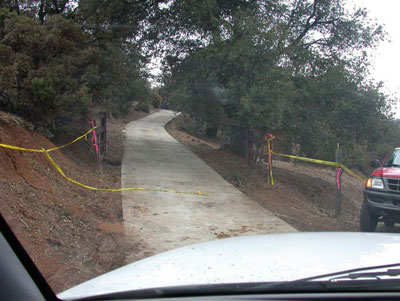
Looking up the driveway at 920 Orchard Lane from its intersection with
Orchard Lane.
Captain McDonald on Engine 6162 orders Engineer Kreps to back the engine
up the cement driveway at 920 Orchard Lane. He then walks up the driveway
ahead of the engine to evaluate the location. Firefighter-Paramedic Smith
on Engine 6162 and Engineer Rucker are cutting brush, which is hanging
over the sides of the cement driveway, and directing the backing of the
engine. [30]
S/T Leader Watkins rejects putting an engine at 930 Orchard Lane as it
is too risky. This is the third residence from the north and directly
south of the residence where Engine 6162 is assigned. [31]
Engine 24 (E5228) from Vallejo is assigned structure protection at 1038
Orchard Lane. The house at 1126 Orchard Lane is skipped and Engine 71
is assigned to the next house to the south. [32]
FC Childe and FAE Sanchez, in Utility 3334, drive north on Orchard Lane,
passing Engines 24 and 71 on Orchard Lane near the driveway of 930 and
920 Orchard Lane. The two engines are headed south to their assigned locations.
[33] , [114]
Engine 334 is parked in a driveway on the east side of the road as FC
Childe and FAE Sanchez pass. FAE Sanchez is video taping as they go, and
the driveway to 920 Orchard Lane is clearly visible in the video as they
pass that location. [114] When
FC Childe passes the engines on the road, he then determines that he is
going to fire-out. [34]
FC Childe and FAE Sanchez continue north on Orchard Lane and observe
an engine (1541) parked near 915 Orchard Lane. Once again FC Childe states
that he has a safety concern about the bulldozers and engines coming in
to do work in the area, [114]
, [35] There is no indication
that he ever conveys that concern to anyone else. FC Childe drives around
the engines. Both FC Childe and FAE Sanchez express their concern about
the engines being able to hold Orchard Lane and state to each other that
they should just get out. [114]
S/T Leader Watkins observes the Fire Captain that he has seen earlier
at the briefing in Santa Ysabel, drive past in a utility and go up towards
902 Orchard Lane.36 FC Childe and FAE Sanchez in Utility 3334 see fire
beyond the northernmost approach to 902 Orchard Lane, so they turn a hard
left up the first drive at 914 Orchard Lane. [114]
While FAE Sanchez sits in the truck, FC Childe parks near the southwest
corner of the driveway and video tapes the fire that passes the property
from the southwest to the northeast. Small torching activity is visible
114 in the immediate area with most of the fire spread being past the
property on the north side. FC Childe describes the main fire as having
passed and local flame lengths are about 25-30 feet. Observing the fire
spread that is now flanking across the slope to the southeast, [37]
FC Childe initiates a firing action around the residence. [114]
, [38]
According to the ICS-214 for FC Childe, he and FAE Sanchez begin to take
“Independent Action on structure protection.” [39]
FC Childe gives FAE Sanchez instructions to fire-out around 902 Orchard
Lane. FAE Sanchez gets into the rear of the truck and prepares a drip
torch. He then goes to the west side of the residence and begins to fire
out. FAE Sanchez has no radio. [40]
FC Childe has given FAE Sanchez the only HT (it is unknown when). [41]
According to FC Childe, the firing-out is just ahead of the fire at all
times. [42] FC Childe continues
to describe the main fire as banking southeasterly towards the structures.
He states that the fire activity “was great until we start(ed) dropping
fire and then they started to pick up and started to flame…”
[43]
FC Childe in Utility 3334 returns to Orchard Lane alone, [44]
and instructs Engine 334 to go to the residence at 902 Orchard Lane and
do structure protection in support of his firing-out operation. [42]
(FC Childe later states that during the firing-out operation, “I
was watching him, what he was doing, making certain that he was in visual
contact with me all the time. And you know, we did that for each structure.”)
[45]
FC Childe makes face to face contact with the Strike Team Leader of S/T
1286A and tells him of his intentions to fire-out around the residence
and the need for an engine. Childe says that the S/T Leader tells him
that they are on White 3 as a tactical channel. FC Childe says that he
later finds out, after unsuccessfully trying to communicate with the S/T
Leader, that it was White 3 on the 800 MHz and he only had VHF. [46]
FC Childe states that there was not a lot of communication going on that
he could hear and he was “getting a little bit unnerved.”
[47]
S/T Leader Watkins sees FC Childe walk by and hears him say, “you
need to start puttin’ fire down on the ground or you’re gonna
start losin’ houses.” [48]
Engine 334 calls S/T Leader Watkins and advises him of the instructions
from FC Childe.
S/T Leader Watkins, believing that FC Childe is going to coordinate and
work with Engine 334, tells the crew to go ahead and support the firing-out
operation. It is days later when Watkins finds out that the crew of Engine
334 thought FC Childe was coordinating the firing-out with the S/T Leader.
Conversely, Watkins thought that FC Childe was going to remain to assist
Engine 334. [39]
S/T Leader Watkins observe a U. S. Forest Service hand crew (El Cariso
Hot Shots) and some bulldozers (LA County) go past him to the north on
Orchard Lane. S/T Leader Watkins assumes the crew and bulldozers, who
are going to work the edge of the fire, are coordinating their efforts
with the firing-out operation. [50]
At 11:57 a.m. Engine 24 arrives at 1038 Orchard Lane. [23]
They observe no visible fire near the structure. Captain Mike Carpenter
hikes about 300 yards uphill behind the house and never sees any fire.
The crew can see a column further north down Orchard Lane, moving from
west to east. [51]
Captain McDonald returns to Engine 6162 after assessing the situation
and expresses some concern about the conditions. Captain McDonald radios
S/T Leader Watkins and advises him that he does not think the house is
defendable. S/T Leader Watkins tells them to come out. According to Captain
McDonald he returns to review the situation with Firefighter-Paramedic
Smith and Engineer Rucker. [52]
At the top of the driveway, they can see smoke from the fire to the north
near 902 Orchard Lane, and determine it to be the primary threat. They
observed it to be a flanking fire. [54]
Captain McDonald, Engineer Rucker and Firefighter-Paramedic Smith walk
to the end of the driveway past the front of the residence, which faces
west towards the San Diego River drainage below. After a review of the
location they find that brush had been cleared away to the west of the
residence for about 150 feet and a decision to deploy at this location
is made. This clearance of brush provides for a view across the canyon
to the west and northwest. Tall brush and drifting smoke restrict the
view to the southwest. [55]
The prominent fire in view at this time is still the flanking fire to
the north near 902 Orchard Lane. Small runs of fire are taking place across
the canyon on the west side of the drainage as it backs down into the
bottom of the canyon. No fire activity is visible to the southwest. The
crew of Engine 6162 observes that there is a wind blowing up-canyon and
upslope on a line from where Highway 78/79 crosses the San Diego River
towards the location of 902 Orchard Lane, a natural saddle. Wind speeds
are estimated at 7-10 mph. [54]
After Engine 6162 arrives at the top of the driveway at 920 Orchard Lane,
the crew conducts a briefing with Captain McDonald laying out the plan
of deployment and preparation. An axe is placed at the rear door in preparation
for forced entry should it be needed. A chain saw is placed on a cement
patio at the south end of the house after doing some additional brush
clearing. The roof is laddered near the front door using one found at
the residence. [57]
The front bumper line is charged and prepared as an engine protection
line should they have to drive out under fire conditions. Two, 100 foot
long, one and one-half inch hose lines are deployed and charged to protect
the structure. These hoses are attached off the rear wye discharge and
are placed to the passenger side of the engine. [57]
FAE Sanchez completes firing around 902 Orchard Lane. He has fired from
south to north along the west side of the residence. FAE Sanchez walks
back to where the utility is parked and finds both it and FC Childe gone.
He walks cross-country down the hill to Orchard Lane where he sees Engine
334 coming up the driveway. He turns and walks back up with the engine.
[58]
At about this time, CDF Copter 202, with Captain Jesse Scofield on board,
tries to contact Engine 334 on Air-to-Ground. Captain Scofield observes
that the winds at his elevation are blowing hard out of the west and beginning
to change to the northwest. [59]
Captain Scofield observes what he thinks are backfires below and close
to the houses on the ridge. He sees firefighters working them with hoses.
He later decides that they were spot fires as they were “round,
not narrow.” He returns to base for fuel and is not able to reach
any ground resources on Air-to-Ground before he leaves. [59]
FC Childe returns with the utility and rejoins FAE Sanchez. The two,
after trying to fire out around an outbuilding, drive out to Orchard Lane.
With FAE Sanchez in the rear of the utility, they proceed south on Orchard
Lane and up the driveway towards 930 Orchard Lane. [60]
FAE Sanchez recalls going to this location and during a field interview
with Investigator Alan Carlson, describes his actions at this location.
FAE Sanchez admits that FC Childe videotaped him burning at this location.
[61] , [114]
FC Childe says that he did not go up the driveway to 930 Orchard Lane.
After walking up there with investigators he states that he has no memory
of burning out in that location. [62]
The crew of Engine 6162 does additional work preparing the residence
for the on-coming flanking fire from the north including the cutting and
removal of additional brush from the area behind the engine. The engine
is moved back about ten feet to avoid subjecting it to heat from a brush
pile the crew burns below the driveway. [63]
S/T Leader Watkins and his assistant arrive at about 12:25 p.m. at 930
Orchard Lane to reevaluate the use of an engine at that location. Shortly
after their arrival, FC Childe and FAE Sanchez in Utility 3334 arrive.
Childe instructs FAE Sanchez to begin firing-out the area around the structures.
This firing is observed by S/T Leader Watkins to be about 100-150 feet
away from the structures and appears to him to be “too big of a
bite as the fire (gets) into the brush and (begins) making a run towards
the driveway.” A helicopter makes a drop on this fire and slows
it down. Utility 3334 is blocking their means of egress. [64]
After FAE Sanchez fires out from south to north along the west side of
the structures at 930 Orchard Lane, FC Childe instructs FAE Sanchez to
take the line of fire to the next house to the north, which is 920 Orchard
Lane. FC Childe is video taping this. [114]
, [65]
In a later interview, FC Childe states, “I’m sure there was
nothing between me and what I was firing out because the fire was just
way too close to these structures that I was, you know, droppin’
fire behind, you know, it just was there. And if there was any engines
out there, they were trapped maybe before I even got there.” [66]
Evidence indicates that at the time that FC Childe and FAE Sanchez fired-out
at 930 Orchard Lane, the main fire was still flanking in the area of 902
Orchard Lane. Engine 6162 at 920 Orchard Lane was between FC Childes’
firing operation and the main fire. (See later sequence of events, firing
out at 920 Orchard Lane.)
The firing-out operation at 930 Orchard Lane quickly generates fire spread
towards the east which is knocked down by the helicopter water drop. [64]
The video tape taken by FC Childe at this location shows that fire is
igniting and spreading at a rate that FAE Sanchez does not feel comfortable
with. FAE Sanchez admits this to be true in a later interview. The video
also shows a wind influencing the fire spread from west to east. The fuels
between where they are firing at 930 Orchard Lane and where Engine 6162
is at 920 Orchard Lane, consist of 15-foot tall brush and oak with grass
underneath [114]. FC Childe
and FAE Sanchez are observed by S/T Leader Watkins as they drive back
down the driveway. [64]
Jay Bertek, the supervisor for the El Cariso Hotshots observes a line
of fire on the ridge between 930 and 920 Orchard Lane. He is unsure of
where this fire is coming from but knows it is not the main fire. He calls
his crew who are working near 902 Orchard Lane and asks them if they are
firing-out. They tell him that they are not. Bertek observes that the
main fire is now “leading sparks.” [56]
FC Childe and FAE Sanchez drive down the driveway of 930 Orchard Lane,
which comes out directly next to the driveway at 920 Orchard Lane. The
two drive up the driveway to 920 Orchard Lane where they park near the
garage. The two get out and FAE Sanchez begins to light fire back towards
the north, in the direction of 902 Orchard Lane. [67]
Captain McDonald walks north on the driveway from the location of Engine
6162. While near the front door of the residence, he observes a CDF pickup
truck arrive at the top of the driveway and park near the garage. He observes
two people get out and one of them starts lighting a fire back to the
north towards 902 Orchard Lane. He does not speak with them, however he
believes the Captain in the truck sees him. He does not see the truck
leave. [67]
Captain McDonald indicates to the members of the crew that there is a
CDF firefighter firing-out in the direction of the garage. Captain McDonald
instructs the crew to fire-out the grass below the driveway. Engineer
Kreps walks north on the driveway to the garage area, and observes fire
on the ground already behind the garage and to the north in the brush.
He then begins his strip-firing from that location to the south along
the edge of the driveway. Captain McDonald throws fusees down the slope
into the heavy brush below the area strip-burned. This results in a partial
burn. [68]
S/T Leader Watkins and his assistant drive back down the driveway of
930 Orchard Lane and along with the S/T Leader for 1286A, park near the
bottom of the driveways of 930 and 920 Orchard Lane. [64]
FAE Sanchez continues to light fire from the driveway at 920 Orchard
Lane towards the driveway at 902 Orchard Lane. Alone, FC Childe in the
utility returns to the bottom of the driveway at 920 Orchard Lane.64 Both
FC Childe and FAE Sanchez deny having been up this driveway or having
fired-out in this area.
The crew superintendent for the El Cariso Hot Shots observes fire along
the ridge between 902 Orchard Lane and 920 Orchard Lane. He again calls
his crew and asks if they are firing-out. The crew has arrived behind
902 Orchard Lane and is starting to contain the fire’s edge along
with the bulldozer. They reply to Bertek that they are not firing-out.
The crew superintendent for El Cariso, concerned about this unexplained
fire on the ridge and spot fires in the meadow to the east of Orchard
Lane, calls his crew out and orders them back to their safety area. [56]
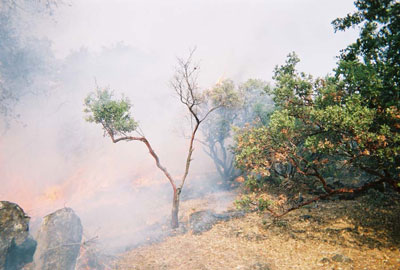
Picture taken by Engineer Kreps of the fire he finds on the ground north
of the garage just before he begins to fire-out from this location.
This is the same area where Capt. McDonald sees two CDF personnel firing-out
at the top of the driveway. View is to the north towards 902 Orchard
Road.
S/T Leader Watkins and his assistant observe FC Childe in Utility 3334
come out the driveway at 920 Orchard Lane alone. FC Childe approaches
them and “adamantly demands(ed) to know why we (do) not have a unit
up there. We inform(ed) him we (do) and proceed(ed) to that location.”
[64]
Watkins and his assistant arrive at the location of Engine 6162 at about
12:35 p.m. and review their progress and plans. Watkins observes that
the sky is clear overhead and the winds are moderate, still up-canyon
and upslope. S/T Leader Watkins writes in his ICS-214 that they spoke
with the Captain and Engineer of Engine 6162 and discussed their situation.
Watkins notes that the crew of Engine 6162 is in the process of strip-burning
and about to throw fusees into the brush. He observes the fire backing
down the ridge from the north and it is about 300 yards to the right of
the house. S/T Leader Watkins sees nothing below the house. [69]
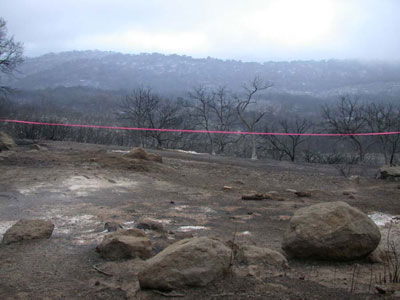
Area below and to the southwest of Engine 6162 where brush had been
cleared and the crew of Engine 6162 strip-burned grass stubble. Capt.
McDonald had thrown fusees into brush below the clearing.
As Watkins and his assistant leave 920 Orchard Lane, they receive a radio
message from Engine 334 at 902 Orchard Lane. Engine 334 tells them that
they have spotting from a firing operation below them which has cut off
their egress. Watkins then heads to that location but is cut off by an
LA County bulldozer working the area. [70]
About five to eight minutes after S/T Leader Watkins leaves the scene,
the crew of Engine 6162 observes an increase in the fire activity below
them. [71]
S/T Leader Watkins sees signs of the fire picking up but still believes
it to be from the northwest, the direction he has always thought it would
come from. [72] It is at about
this time that he begins to hear the fire.
FC Childe picks up FAE Sanchez and they then drive south on Orchard
Lane towards 1038 Orchard. FC Childe and FAE Sanchez, arrive at 1038 Orchard
Lane followed by a news 50,114 They observe firefighters sitting in chairs
and FC Childe tells them to get out of the chairs. [73]
According to members of Engine 24, Captain Childe gets out of the truck
and tells the firefighters in the chairs to “Get out of the fuckin’
chairs before I break you guys’ heads.” Captain Childe then
advises their Captain that he is going to fire-out. FAE Sanchez starts
to fire-out in a semi-circular area that begins near the driveway, proceeds
to the rear of the house and then swings back towards Orchard Lane. [76]
FAE Sanchez can hear the fire picking up from the west and hears the
sounds of a sustained rapid fire run. FC Childe says that the firing-out
at 1038 Orchard Lane takes place about 2-3 minutes before the main fire
hits that location.74 FAE Sanchez, concerned about the situation tells
FC Childe that he is going to stay and help the crew. [75]
[114]
The crew of Engine 24 reports that prior to this action there is little
or no wind in the area. The crew observes fire from the firing operation
spread to the brush and ignite an outbuilding. The fire intensifies, crosses
over the driveway and cuts off the Engine crew’s egress. The crew
becomes encircled by fire and the wind changes directions and becomes
erratic. [77] (This occurs about
1:00 p.m. according to Childe. [113]
Burn indicators, observations from Ron Mitchell the resident at 1126
Orchard Lane, and news video footage, indicate that at about this time
the flank of the main fire begins a run from the bottom of the drainage
to the northeast. [116] Burning
upslope and up-canyon influenced by a combination of up-canyon and westerly
winds, the fire forms a major front which burns in continuous fuels directly
towards the area of 920 and 930 Orchard Lane. [80]
Ron Mitchell notices a sudden wind shift with winds beginning to blow
hard from the west. “And then all (of) the sudden there (is) this
huge, the wind (is) fierce and there (is) this huge wall of flame that
(comes) through, between my property and Hubble’s property.”
(930 Orchard Lane) [80] He observes
smoke cover the area north of his house and he sees flames getting big
to the north of his house. Within a short time, the flames are near his
house and he decides to evacuate. By the time he makes it down to Orchard
Lane, he notices the time is 1:15 p.m. and the fire has burned past his
house down to Orchard Lane along his driveway. [80]
During this same time period, the operator of the Los Angeles County
bulldozer, Jeff Vidrinskas is notified by his transport driver, Michael
Rodan (who is located near Highway 78/79 and Orchard Lane) that the fire
is becoming very active. Vidrinskas takes his bulldozer down off the west
side of the driveway at 902 Orchard Lane in a flanking action. Within
a few minutes and less than 100 feet down the hill from the driveway,
Vadrinskas pushes over an oak tree. As he does this he observes a wall
of fire ahead of him. He describes it as a wall of flame well over 100
feet tall and over 300 yards wide. Looking to his left and right, all
that Vadrinskas can see is the wall of fire. He pulls back to the driveway
at 902 Orchard Lane. [108]
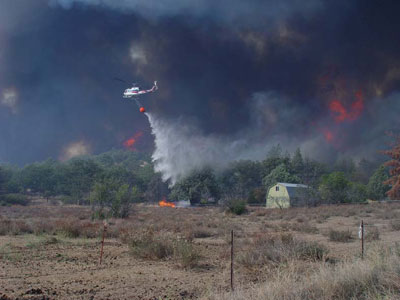
Main fire running
from southwest to northeast. Viewed from Orchard Lane near 1038 Orchard.
Flames on the right in background are near 930 Orchard Lane.

Fire picking up below
the crew of Engine 6162 just as they begin to retreat back to the engine
from firing-out. Photo taken by Engineer Kreps.
The crew of Engine 6162 gathers at the engine to talk. As the fire intensity
increases, the crew decides to retreat to the passenger side of the engine
away from the radiant heat below them. Firefighter-Paramedic Smith staffs
a one and one-half inch hose line at the front passenger side while Engineer
Rucker staffs a similar hose line near the rear passenger side. Engineer
Kreps is standing at the rear duals on the passenger side with his back
to the engine.
Captain McDonald is just to the rear of Firefighter-Paramedic Smith.
[110] Firefighter-Paramedic
Smith observes Captain McDonald closer to the rear bumper than Engineer
Rucker. [111] Engineer Kreps
states that all four members of the crew make it around to the passenger
side of the engine. Kreps says that they move around, including walking
to the tailboard of the engine (See photo taken by Engineer Kreps). Kreps
recalls Firefighter-Paramedic Smith being forward of his position (towards
the front bumper). Kreps has his back to the engine rear duals, and Engineer
Rucker is directly in front of him no more than five feet away. [112]
Captain McDonald has the only portable radio. [81]
As Firefighter-Paramedic Smith takes his position at the front of the
engine, he notices hot embers blowing into the juniper bushes on the patio
behind him. He uses his hose to knock down some fire in the bushes. [85]
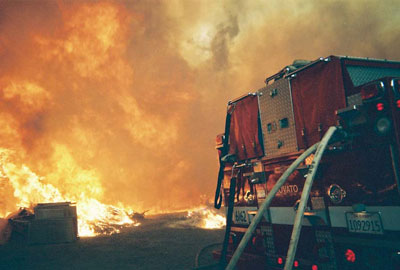
Picture taken by Engineer Kreps as he steps out from behind the cover
of the passenger side of the engine.
Captain McDonald states about this time, “The sky start(s) turning
orange, and it just (got) – at that point in time – became
pretty untenable outside. So, I order(ed) the crew to deploy inside the
structure.” [82] Firefighter-Paramedic
Smith describes the conditions as, “Uh, full sunlight to the point
where we went around the engine, to that twilight, darkness and smoke
and the orange glow and fire embers going constant past the engine, the
heat, the heat intensity dramatically start(ed) to pick up.” [83]
Engineer Kreps states, “that’s when the sky got dark, it
started getting real hot, embers flying everywhere, and it just, the sound
of the, you know, the freight train coming, it was getting worse and worse
and worse and we decide that before it got any worse, we better retreat
to the house.” [84]
Members of the crew notice a significant wind increase at this time.
A flaming front is observed by Firefighter-Paramedic Smith blowing across
the driveway in the direction of the garage, cutting off their egress.
[86] Captain McDonald orders
the crew to move to the shelter of the residence. [82]
At about the same time, S/T Leader Watkins, positioned near 915 Orchard
Lane, sees fire “blowing through” the area of the ridge north
of Engine 6162 and south of 902 Orchard Lane. He estimates this event
to last about 15 seconds. Visibility is down to a few feet due to heavy
smoke and S/T Leader Watkins later states “you could hear the fire
at that point. It was, it was comin’ and it was rippin’.”
[87]
Juniper and Boxwood bushes planted along the cement patio behind the
crew of Engine 6162 burst into flame. Responding to Captain McDonald’s
order to get into the structure, Firefighter-Paramedic Smith immediately
drops his hose line and runs in the direction of the three-foot high raised
patio. (During the accident scene investigation, a nozzle and hose remains
were located on the ground just forward of the front bumper on the passenger
side, consistent with Smith’s statement.) Immediately upon leaving
the protection of the engine, Firefighter-Paramedic Smith experiences
severe thermal conditions. He leaps past the burning bushes and onto the
patio. He is followed closely by Engineer Kreps who runs to the steps,
stumbles and falls to his knees at the top of the steps, recovers and
continues to retreat behind the rear of the house following Firefighter-Paramedic
Smith. It is a distance of about 170 feet to the rear door. [88]
Captain McDonald, moves towards the steps of the patio and accounts for
Engineer Kreps and Firefighter-Paramedic Smith while they make it up onto
the patio and around the rear corner of the house. He then turns back
towards the rear of the engine to account for Engineer Rucker. He does
not understand why Engineer Rucker is taking so long. Near the rear of
the engine Captain McDonald locates Engineer Rucker, who appears to him
to be dazed and confused. [89]

Steps which the crew members used to get up onto the patio.
Captain McDonald starts yelling at Engineer Rucker to move to the house.
“Now, Steve, looked back and Steve’s at the back of the Type
3 and, I said, Steve, c’mon let’s go. We gotta deploy. And
he’s still on the, I just don’t know at this point in time
exactly. I mean, I could see what the other guys, had a mission and purpose
to get inside the structure. Steve, he didn’t seem to have mission
and purpose. He was just kind of, he started, so as I talked to him he,
he turned his head and almost started walking the opposite way and I said,
Steve, c’mon, let’s go. We gotta get in there. We have to,
and he goes, uh, and he started coming towards me, he said, ‘Oh,
I’m burning up.” [89]
Captain McDonald observes Engineer Rucker take two steps toward him and
fall to the ground. Captain McDonald sees him “(get) up on all fours”
and stand back up. Engineer Rucker then turns toward the tailboard of
the engine and McDonald thinks he takes a “half step” in that
direction. He notes that Engineer Rucker is looking in a southeast direction.
[110]
Engineer Rucker turns towards McDonald and states “I’m burning.”
McDonald sees Engineer Rucker step towards him and then turn towards the
bushes and the patio. Rucker then falls face-forward into the burning
bushes. Captain McDonald moves towards Engineer Rucker who is already
pushing himself away from the bushes. McDonald assists Engineer Rucker
to the steps and Engineer Rucker makes it up the steps under his own power.
McDonald notes that Engineer Rucker is slightly hunched over at the waist.
[89] , [110]
He then follows Engineer Rucker up the steps to the patio. [89]
Physical evidence located at the top of the steps, including a gated-wye,
fusees, hose spanner, and flagging from pouches attached to the web gear
of Captain McDonald, indicate that Captain McDonald’s web gear was
failing at this time and equipment was falling off. This was most likely
due to burning of the web gear and pouch.
No member of the crew has any recollection of Engineer Rucker having
a wildland hose pack on, and Captain McDonald has no recollection of instructing
Engineer Rucker to don a hose pack at this time. However, physical evidence
recovered from and around the body of Engineer Rucker clearly indicates
that he had a 200 foot, one and one-half inch wildland Gnass hose pack
on his back. These packs are located in the middle rear compartment of
Engine 6162. An inventory of the engine after the accident shows that
one 200-foot wildland hose pack is missing from this compartment.
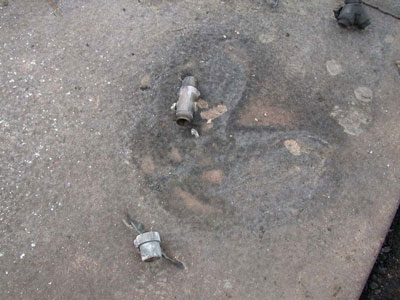
Burnt outline of first
100 feet hose pack dropped near the feet of Engineer Rucker on patio.
In-line Tee visible in upper middle portion of photo.
Physical evidence at the scene shows that as Captain McDonald and Engineer
Rucker crossed the patio, the first 100 feet of the hose pack fell to
the ground and burned without having been deployed fully. It cannot be
determined if this was due to an intentional deployment or failure of
the hose pack.
Captain McDonald observes Engineer Rucker fall to the ground on the patio
(within a few feet of the first 100-foot bundle of hose). Captain McDonald
makes an attempt to get Engineer Rucker up but cannot. [89]
A King portable radio belonging to the Novato Fire District is later
found on the ground next to the body of Engineer Rucker on the side nearest
the steps. This radio had been carried by Captain McDonald and was being
used to transmit on the tactical channel. Captain McDonald has no recollection
of making a radio transmission next to Engineer Rucker at this point in
time.

King portable radio
left on patio just to the west side of Engineer Rucker (between Rucker
and patio steps)
S/T Leader Watkins, from his position near 915 Orchard Lane observes
the fire front hit the entire area and roll over the ridgetop down towards
Orchard Lane, from 902 Orchard Lane down to 1038 Orchard Lane where Engine
71 is located. The conditions go from hazy to dark to hazy again within
just a couple of minutes. His assistant gets on the radio and begins to
do radio checks with the units. It is at this time that they hear a radio
call on the tactical channel from Engine 6162 that they have a man down.
[90] Documented times for this
transmission from other units who heard the call on the tactical channel
range from 12:45 p.m. [91] to
12:55 p.m. [92] Water tender
operator Marchisio writes in his ICS-214, “1245, Heard radio transmission
over tactical net reporting- Firefighter down, followed by –Not
able to get in his shelter.” [91]
Captain McDonald states that he “turned like 180 degrees trying
to yank him (Engineer Rucker) up.” [89]
This is consistent with the physical evidence found at the scene indicating
that the second 100-foot bundle of hose from the hose pack had been pulled
away from Engineer Rucker in the 180-degree direction described by Captain
McDonald, towards the rear of the patio.
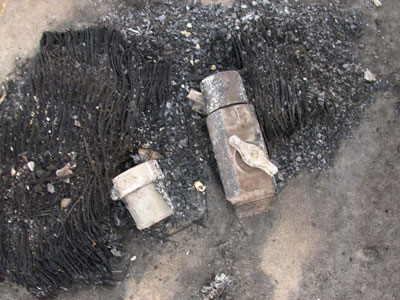
Second 100 feet of hose pack found just above and next to the right
shoulder of Engineer Rucker.
Captain McDonald yells for the other two crew members to return but cannot
be heard due to the noise of the fire. McDonald is aware that, “at
(this) point in time, I’m fryin’ and I know that I’m
getting badly burned…” [89]
The fire has reached the ridgeline and is being funneled across the ridge
to the east. Physical evidence recovered at the accident scene indicates
that fire impinging upon the charged hose lines coming off the rear of
the engine causes the hose to fail and the engine tank is pumped almost
dry.
Captain McDonald, feels himself getting burned, and walks around the
rear corner of the house. He then returns around the corner onto the patio
to make another attempt at getting Engineer Rucker up. He observes that
Engineer Rucker’s body is on fire and determines that he is beyond
help and turns back toward the rear of the residence. [89]
Having arrived at the rear door, Firefighter-Paramedic Smith and Engineer
Kreps use the pre-positioned axe and kicking to force the door open. The
two of them enter into the rear of the residence. Turning around, they
realize that there is no one else following them. They decide to return
and look for Captain McDonald and Engineer Rucker. [92]
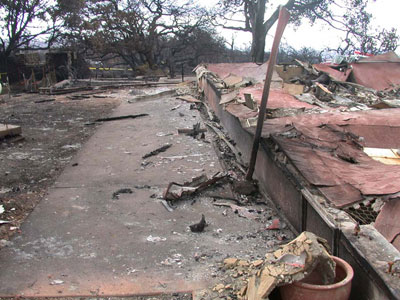
View from near the rear door of the residence looking toward the patio.
This is the path taken by the crew after turning the corner from the
patio, and the route used to return to look for missing crew members.
Tree located in upper right corner of photo is next to the location
where Engineer Rucker went down for the third and final time.
Firefighter-Paramedic Smith and Engineer Kreps travel back along the
rear of the house to the south end, using the house as protection. As
they near the southeast corner of the house, near the patio, they observe
that beyond the end of the house there are solid flames blowing sideways,
including the area of the patio. Just as they arrive at the corner, Captain
McDonald staggers around the corner out of the flames. He appears to be
burned and dazed. [92]
Captain McDonald tells the other two that Engineer Rucker has fallen
and tells them they need to go back for him. Captain McDonald turns to
go back after the fallen Engineer. Engineer Kreps and Firefighter-Paramedic
Smith determine the patio area is not tenable. They see direct flame and
feel an extreme amount of heat in the patio area. Taking the Captain with
them, the three retreat back into the rear door of the residence. [92]
Inside the residence, feeling himself burning, Captain McDonald takes
off his web gear. He searches for his King portable radio but cannot find
it to make a call out for help. The three discuss a plan to search for
Engineer Rucker. [93]
After a moment, a decision is made to open the front door slowly and
check to see if the area in front of the house is tenable. When the door
is opened, intense heat surges through the small opening. The door is
quickly closed. After another few minutes, a decision is made to check
the front door again. This time the heat has subsided and Engineer Kreps
exits the doorway in search of the missing Engineer. Firefighter-Paramedic
Smith attempts to exit the door but is forced back by a wave of heat.
He remains inside the residence and cares for the Captain. [95]
Engineer Kreps moves towards the front bumper line of the engine taking
small shallow breaths. He passes the front of the patio and observes the
body of Engineer Rucker midway across the patio. Kreps continues to the
bumper line and advances it towards the body. Opening the nozzle, he gets
a 10 to 15 second burst of water before the engine’s tank is dry.
[95]
At this time, an increase in fire intensity forces Engineer Kreps to
take shelter in the rear seats of the engine. Once inside, Kreps considers
deploying the extra fire shelters stored in the cab. Concerned that Firefighter-Paramedic
Smith and Captain McDonald may think another member of the crew is down
and come searching for him, Engineer Kreps takes a single breath and runs
to the front door. Firefighter-Paramedic Smith, in the house, begins to
open the door in an effort to go after Engineer Kreps. As Firefighter-Paramedic
Smith opens the door to look for him, Engineer Kreps steps inside and
rejoins the other two. [95]
While the three of them sit near the front entrance of the house, the
north end of the structure begins to burn. Smoke begins banking down to
waist level and a decision is made by the group to try and get to the
engine. The three exit the front door. The Captain is assisted to the
front passenger seat. Firefighter-Paramedic Smith runs to the rear of
the engine and disconnects the two protection lines. He then enters the
cab at the rear passenger seat. Engineer Kreps gets into the driver’s
seat. [96]
Engineer Kreps engages the drive for the engine and slowly drives towards
the north and turns down the driveway to the east. Heavy, dark smoke obscures
the driveway. Engineer Kreps is forced to feel his way down the driveway
using the feel of the tires dropping off the edge of the pavement to make
corrections. At one location, the engine is stopped to avoid running off
the road and getting hung up on a tree. After a short pause, concern about
being overrun by the fire again convinces them that they need to move
forward. [96]
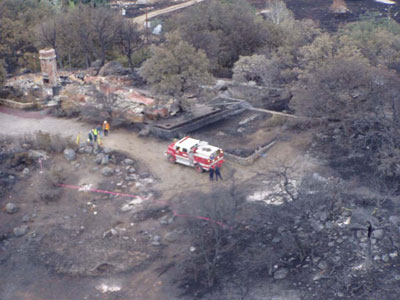
Photo taken after the accident with Engine 6162 placed back into position
of where it was during the burn-over. The Engine is facing north. Fired-out
area shown in lower left corner of photo. Steps used to access patio
are just north of the engine. Engineer Rucker’s body was found
just below tree on patio.
At 1:05 p.m., during the descent of the driveway, the Captain gets on
the radio and transmits a firefighter down message on Command Net.97 S/T
Leader Watkins, hearing that the crew is leaving one person behind, gets
onto Command Net and calls for air drops and a medivac. 98,115 S/T Leader
Watkins and Division I exchange radio traffic on the situation and discuss
the possibility of a rescue attempt for the downed Engineer. [98]
Engine 6162 is successfully driven to the bottom of the driveway and
onto Orchard Lane. S/T Leader Watkins, only 25 to 30 feet from the end
of the driveway and in heavy smoke, does not see the engine leave. [98]
Engine 6162 travels down Orchard Lane to the south. At 1:09 p.m., [97]
Captain McDonald again makes a radio transmission on Command Net to other
units concerning the incident. Captain McDonald orders the engine to stop
in the road and he gets out. The crew members assist him back into the
engine. They continue towards Highway 78/79. At 1:10 p.m., the three crew
members of Engine 6162 arrive at the south end of Orchard Lane just short
of Highway 78/79 where they found the Plumas Hotshots. [99]
The three crew members of Engine 6162 exit the engine and announce to
the Plumas Hotshot crew that they have been burned.
S/T Leader Watkins and his assistant position their command vehicle at
the bottom of the driveway at 920 Orchard Lane in an attempt to evaluate
the potential of going to the aid of the downed Engineer. Conditions preclude
a safe effort to go up the driveway and they stay near the bottom. [100]
About this time, CDF Copter 202 with FC Scofield, returns to the area
and observes that the ridge where they have been working previously is
smoked-in and the winds are out of the northwest. Shortly after that,
he hears Branch III on Air-to-Ground net ask the Air Tactical Group Supervisor
for agency ships in the area to conduct a medivac. [59]
USFS Engine 39 arrives at about 1:11 p.m. [57]
at the medical treatment area and volunteers to conduct a search and rescue
operation at 920 Orchard Lane. They drive through heavy smoke conditions
on Orchard Lane and meet with S/T Leader Watkins at the bottom of the
driveway of 920 Orchard Lane. Engine 39 gets the layout from the strike
team leader and then the five-person engine crew drives to the scene.
[101]
Engine 39 arrives at the scene at about 1:15 p.m. and after discovering
the body of Engineer Rucker, announces an “11-44” at 1:18
p.m. [102] S/T Leader Watkins
states that within a minute or two of this broadcast, he hears a loud
release of pressure which he thinks is a propane tank release. Watkins
then hears Engine 39 make a radio transmission stating that they have
a propane tank venting with flames. All equipment is ordered out of the
area. [103]
FC Childe and FAE Sanchez are finishing their independent firing-out
operation around the last house on the south end of Orchard Lane at this
time. Near the last house, FC Childe stops and does a 15 to 20-second
interview with the news media. At no time does FC Childe hear any traffic
about anyone being overrun by fire or being hurt. FC Childe sees the entire
strike team of engines pulling out and does not know why. He then conducts
a recon to make sure all the engines are out. [104]
FC Childe admits that at no time during the entire operation does he
attempt to contact the Division Supervisor and advise him of his intended
actions. Childe does not see the Division Supervisor during his activities
on Orchard Lane that day. FC Childe states that “I didn’t
even give it a thought to call the Division because I didn’t really
have a lot of time to try.” [105]
FC Childe and FAE Sanchez drive to the south end of Orchard Lane. It
is not until they arrive near Highway 78/79 that they discover that someone
has been burned. FC Childe sees the Novato Engine (6162) for the first
time. [106]
FC Childe later states that he hoped the Novato Engine had been located
some place north of where the main fire made its run. [106]
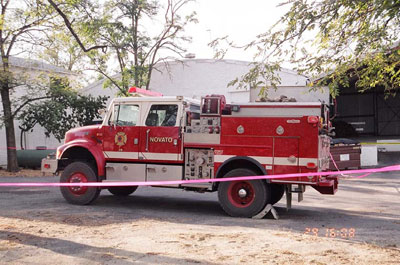
Engine 6162 at initial medical treatment area at 3:08 p.m. on Oct. 29,
2003. Note the time stamp on the photograph is one hour ahead of the
correct time.
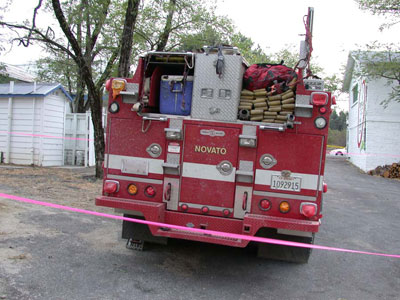
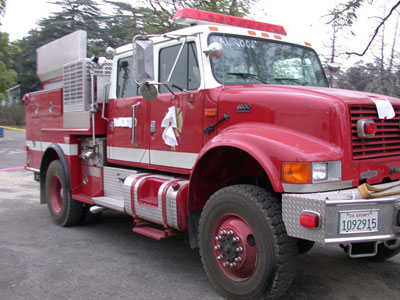
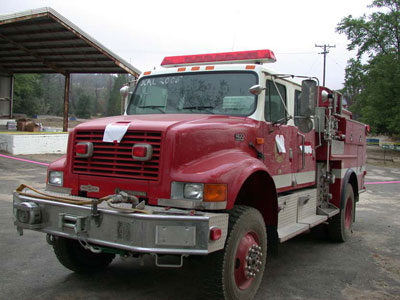
Post Accident Treatment
The Plumas Hotshots are staged at Hwy 78/79 and Orchard Lane at approximately
1:00 p.m. They hear radio traffic about an engine burn-over and firefighter
injuries.
At approximately 1:03 p.m., the Julian Fire Department Paramedic Ambulance
is notified by radio that San Diego County Sheriff Deputies are transporting
a patient of a vehicle accident to the Julian Fire Station, #71. The patient
is reported to have been rear ended while in a black sports utility vehicle
on Hwy 78/79 near Farmer Lane. This accident takes place just east of
where Highway 78/79 crosses the San Diego River. The medics do not see
the vehicle accident scene. (This incident causes initial confusion as
to the location of the burn-over.)
The Sheriff Deputies bring the patient of the vehicle accident to the
Julian Fire Station at about 1:08 p.m. Julian Fire Paramedic Chris Yeary
initially treats this patient. While packaging the vehicle accident patient,
Paramedic Yeary is told about firefighters being burned. Paramedic Yeary
requests that the backup Julian Fire Department Ambulance respond to this
location to treat the victim of the vehicle accident.
The vehicle accident patient was reported to be an out-of-state volunteer
firefighter who was assisting in the fire fighting efforts. Mercy Air
Flight transported the victim to the hospital.
At about 1:10 p.m., Engine 6162 arrives at the intersection of Orchard
Lane and Highway 78/79. They advise the Plumas Hotshots there that they
are the engine crew that was burned-over. The Plumas Hotshots triage the
patients and administer medical assistance to the injured firefighters.
Advanced Life Support (ALS) ambulances and medical helicopters are requested.
Captain McDonald is triaged as the most severely injured with 1st, 2nd,
and 3rd degree burns. Captain McDonald is in need of immediate ALS intervention.
Prior to being treated for their own burns, Engineer (Paramedic) Kreps
and Firefighter-Paramedic Smith from Engine 6162 use the ALS equipment
from their engine to start two IVs on Captain McDonald.
Engineer Kreps tells Cedar Incident Safety Officer John Simon that Engineer
Rucker is an “1144” at the burn-over scene. Engineer Kreps
states that Engineer Rucker was fully involved in fire when he last saw
him.
At approximately 1:27 p.m., the first Julian Paramedic Ambulance with
Paramedic Yeary arrives at Engine 6162’s location. Captain McDonald
is packaged and transported to a landing zone. CDF Copter 202 transports
Captain McDonald and Paramedic Valentini to Ramona Airport to rendezvous
with a Mercy Air Helicopter at about 1:52 p.m. Captain McDonald is transferred
to the Mercy Air Crew and transported to the University of San Diego Burn
Center.
CDF Copter 406 transports Engineer Kreps and Firefighter-Paramedic Smith
to Ramona Airport at 1:56 p.m. to rendezvous with a Mercy Air Helicopter.
Paramedic Yeary treats Kreps and during the flight. At Ramona, Kreps and
Smith are transferred to the Mercy Air Crew for transport to the University
of San Diego Burn Center.
<<< continue
reading—Findings>>>
References
1. Written statement by John Michelini dated 11-02-03.
See tab section 20 of Attachments.
2. Typed statement by Thomas Keating fax date of 11-03-03.
See tab section 21 of Attachments.
3. Interview and written statement by Jim Watkins dated
October 30-31, 2003. See tab section 24 of Attachments.
4. ICS 214 by Ray Chaney for operational period of
October 29, 2003. See Tab section 17 of Attachments.
5. Typed statement by Ray Sauceda. See tab section
56 of Attachments.
6. E-mail from Roger Raines on documenting telephone
interview with Michelini and Chandler on November 25, 2003. See tab
section 22 of Attachments.
7. Tape-recorded interview with Dan Runnestrand on
November 2, 2003. See tab section 23 of Attachments.
8. ICS 214 by Jim Watkins for operational period of
10/29/03. See tab section 24 of Attachments.
9. Tape recorded interview and written statement by
Jim Watkins. See tab section 24 of Attachments.
10. Tape recorded interview with John Childe on October
31, 2003. See tab section 50, page eight and 46 of Attachments.
11. Tape recorded interview with John Childe on October
31, 2003. See tab section 50, page 12 of Attachments.
12. Tape recorded telephone interview with Mike Wakoski.
See tab section 18 of Attachments.
13. Tape recorded interview with John Childe on October
31, 2003. See tab section 50, page 46 of Attachments.
14. Tape recorded interview with Jim Watkins on October
31, 2003 See tab section 24, page 29 of Attachments.
15. Tape recorded interview with Dan Runnestrand
on November 2, 2003. See tab section 23, page 15 of Attachments.
16. Tape recorded interview with Smith on October
30, 2003. See tab section 27, page 12 of Attachments.
17. Tape recorded interview with Shawn Kreps on October
30, 2003. See tab section 28, page 11 of Attachments.
18. Written statement by Captain Michael Carpenter,
Vallejo Fire Dept. dated 10/30/03. See tab section 36, page one and
two.
19. Tape-recorded interview with S/T Leader Watkins.
See tab section 24 of Attachments page 19.
20. Tape-recorded interview with Dan Runnestrand
in tab section 23 of Attachments page nine. Also mentioned on ICS 214
of Mike Wakoski in tab section 18 of Attachments.
21. Tape-recorded interview with Hunter Ridenour.
See tab section 57 of Attachments.
22. Tape-recorded interview with Ron Mitchell. See
tab section 44 page three and four of Attachments.
23. ICS 214 for Oct. 29, 2003, by Capt. Carpenter
showing arrival at assignment at 1068 Orchard Lane at 11:57 a.m. See
tab section 36 of Attachments.
24. Tape-recorder interview with S/T Leader Watkins.
See tab section 24, page 24 in Attachments.
25. Tape-recorded interview with S/T Leader Watkins.
See tab section 24, page 26 in Attachments.
26. Tape-recorded interview with FC John Childe.
See tab section 50, page 14 of the Attachments.
27. Tape-recorded interview with S/T Leader Watkins.
See tab section 24, page 37 of the Attachments.
28. Tape-recorded interview with S/T Leader Watkins.
See tab section 24, page 28 of the Attachments.
29. Tape-recorded interview with S/T Leader Watkins.
See tab section 24, page 27 of the Attachments.
30. Tape-recorded interviews with FF Smith and Engineer
Kreps. See tab section 27, page 20 and tab section 28, page 13-14 of
the Attachments.
31. Tape-recorded interviews with FF Smith, Engineer
Kreps, Capt. McDonald, and S/T Leader Watkins. See tab section 27, pages
20-21; tab section 28 page 14-15; section 26, page 19 of the Attachments.
32. See S/T Leader Watkins statements and crew statements
in tab sections 24, 36,37, 38, 39 of the Attachments.
33. Tape-recorded interview with FC John Childe.
See tab section 50, page 16 of the Attachments.
34. Tape-recorded interview with FC John Childe.
See tab section 50, page 51 of the Attachments.
35. Tape-recorded interview with FC John Childe.
See tab section 50, page 16 of the Attachments.
36. Tape-recorded interview with S/T Leader Watkins.
See tab section 24, page 29 of the Attachments.
37. Tape-recorded interview with FC Childe. See tab
section 50, page 20 of the Attachments.
38. ICS-214 for 10-29-03, FC John Childe. See tab
section 50, ICS-214.
39. Tape-recorded interview with FC Childe and ICS
214. See tab section 50, page 32, of Attachments and tab section 50,
ICS-214 for 10-29-03 by FC Childe.
40. Tape-recorded interview with FAE Sanchez. See
tab section 51, page 12 of Attachments.
41. Tape-recorded interview with FC Childe. See tab
section 50, page 44 of Attachments.
42. Tape-recorded interview with FC Childe. See tab
section 50, pages 21 and 38 of Attachments.
43. Tape-recorded interview with FC Childe. See tab
section 50, page 53 of Attachments.
44. Tape-recorded interview with FC Childe. See
tab section 50, page 19 of Attachments.
45. Tape-recorded interview with FC Childe. See tab
section 50, page 51 of Attachments.
46. Tape-recorded interview with FC Childe. See tab
section 50, page 26 of Attachments.
47. Tape-recorded interview with FC Childe. See tab
section 50, page 27 of Attachments.
48. Tape-recorded interview with S/T Leader Watkins.
See tab section 24, pages 29-30 of Attachments.
49. Tape-recorded interview with S/T Leader Watkins.
See tab section 24, page 37 of Attachments.
50. Tape-recorded interview with S/T Leader Watkins.
See tab section 24, page 38 of Attachments.
51. Typed statement by Capt. Carpenter of engine
24. See tab section 36 of Attachments.
52. Tape-recorded interviews with Capt. McDonald.
See tab section 25, page three of Attachments.
53. Tape-recorded interviews with FF Smith and Engineer
Kreps. See tab section 27, page 21 and tab section 28, page 15 of Attachments.
54. Tape-recorded interview with FF Smith. See tab
section 27, pages 25-26 of Attachments.
55. Tape-recorded interview with FF Smith. See tab
section 27, pages 21-22 of Attachments.
56. Tape-recorded interview with El Cariso Hot Shot
Superintendent Jay Bertek. See tab section 52, pages 11-12 of Attachments.
57. Tape-recorded interviews with FF Smith, Capt.
McDonald and Engineer Kreps. See tab section 26, page. five; tab section
27 pages 29-30; tab section 28, page. 18 of Attachments.
58. Tape-recorded interview with FAE Sanchez. See
tab section 51, page. 11-12 of Attachments.
59. Written statement by Capt. Scofield on Copter
202, dated 11-02-03. See tab section 59 of Attachments.
60. Tape-recorded interview with FAE Sanchez. See
tab section 51, pages 14-15 of Attachments.
61. Supplementary Investigation Report 0-4/c. See
tab section 51, Supp. report by Alan Carlson.
62. Supplementary Investigation Report 0-4/d. See
tab section 50, Supp. report by Alan Carlson.
63. Tape-recorded interviews with FF Smith and Engineer
Kreps. See tab section 27, pages 30-31; tab section 28, pages 17-18
in Attachments.
64. Typed statement by Asst. S/T Leader McLaughlin.
See tab section 25, page four of Attachments.
65. Tape-recorded interview with FAE Sanchez. See
tab section 51, pages 17-20 of Attachments.
66. Tape-recorded interview with FC Childe. See tab
section 50, page 65 of Attachments.
67. Tape-recorded interview with Capt. McDonald.
See tab section 26, pages four, 14 and 15 of Attachments.
68. Tape-recorded interviews with FF Smith, Engineer
Kreps, and Capt. McDonald. See tab section 27, pages 33; tab section
28, pages 21-23, 42 of Attachments.
69. Tape-recorded interview with S/T Leader Watkins
and his ICS-214 for 10-29-03. See tab section 24, page 48 and ICS-214
last page, in attachment.
70. ICS-214 by S/T Leader Watkins. See tab section
24, last page of ICS-214 in attachment.
71. Tape-recorded interviews with Capt. McDonald,
FF Smith, Engineer Kreps, and S/T Leader Watkins. See tab section 26,
page 31; tab section 27, Pages 35-36; tab section 28, page 41; tab section
24 ICS-214 for S/T Leader Watkins.
72. Tape-recorded interview with S/T Leader Watkins.
See tab section 24, page 49 of Attachments.
73. Tape-recorded interview with FC Childe. See tab
section 50, pages 40 and 23 of the Attachments.
74. Tape-recorded interview with FC Childe. See tab
section 50, page 23 of Attachments.
75. Tape-recorded interview with FAE Sanchez. See
tab section 51, page 24 of Attachments.
76. Written supplemental report by Kevin Johnston
with the crew of engine. See tab section 36, supplemental interview
first page, Attachments.
77. Typed statement of Capt. Carpenter. See tab section
36 of Attachments.
78. (Expansion space holder)
79. (Expansion space holder)
80. Tape-recorded interview with Ron Mitchell. See
tab section 44, page five of Attachments.
81. Tape-recorded interviews with Capt. McDonald,
FF Smith and Engineer Kreps. See tab section 26, pages 21-22; tab section
27, pages 38-39; tab section 28, pages 26-27 of Attachments.
82. Tape-recorded interview of Capt. McDonald. See
tab section 26, page 6 of Attachments.
83. Tape-recorded interview of FF Smith. See tab
section 27, page 38 of Attachments.
84. Tape-recorded interview of Engineer Kreps. See
tab section 28, page 26 of Attachments.
85. Tape-recorded interview with FF Smith. See tab
section 27, page 39 of Attachments.
86. Tape-recorded interview with FF Smith. See tab
section 27, pages 39-40 of Attachments.
87. Tape-recorded interview with S/T Leader Watkins.
See tab section 24, pages 53-54 of Attachments.
88. Tape-recorded interview with FF Smith and Engineer
Kreps. See tab section 27, pages 41-42; tab section 28, page 27 of Attachments.
89. Tape-recorded interview with Capt. McDonald.
See tab section 26, pages six through eight of Attachments.
90. Tape-recorded interview with S/T Leader Watkins.
See tab section 24, pages 55-56 of Attachments.
91. ICS-214 from C. Marchisio, see tab section 90
of Attachments. Tape-recorded interview with S/T Leader Watkins. See
tab section 24, page 56 of Attachments section. Written statement by
Ryan Bauer. See tab section 86, page one of Attachments.
92. Tape-recorded interviews with FF Smith and Engineer
Kreps. See tab section 27, pages 42-44, 46 and tab section 28, pages
27-28 of Attachments.
93. Tape-recorded interview with Capt. McDonald.
See tab section 26, page 27 of first interview and McDonald second interview
in tab section 26.
94. Second tape-recorded interview with Capt. McDonald.
See tab section 26.
95. Tape-recorded interviews with FF Smith and Engineer
Kreps. See tab section 27, pages 47-48 and tab section 28 pages 28-30
of Attachments.
96. Tape-recorded interviews with FF Smith and Engineer
Kreps. See tab section 27, pages 48-50 and tab section 28, pages 31-32
of Attachments.
97. General Message form by Mike Brown. Time stamped
on PDA. See tab section 75 of Attachments. Also on ICS-214 by Mike Brown.
98. Tape-recorded interview with S/T Leader Watkins.
See tab section 24, page 58 of Attachments.
99. Written statement by Plumas Hot Shot FF. Ryan
Bauer. See tab section 86, of Attachments.
100. Tape-recorded interview with S/T Leader Watkins.
See tab section 24, page 59 of the Attachments.
101. Tape-recorded interview with S/T Leader Watkins.
See tab section 24, page 60 of attachment. Tape-recorded interview with
Brian Rhodes. See tab section 64, pages 8-9 of Attachments.
102. Typed statement by Fire Fighter Ryan Stewart,
USFS Engine 39. See tab section 66, page two of Attachments.
103. Tape-recorded interview with S/T Leader Watkins.
See tab section 24, page 62 of Attachments.
104. Tape-recorded interview with FC Childe. See
tab section 50, pages 28, 29 and 44 of the Attachments.
105. Tape-recorded interview with FC Childe. See
tab section 50, pages 42 and 43 of the Attachments.
106. Tape-recorded interview with FC Childe. See
tab section 50, page 30 of the attachment.
107. Tape-recorded interview with Dozer Operator
Jeff Vidrinskas. See tab section 54, page seven of the Attachments.
108. Tape-recorded interview with Jeff Vidrinskas.
See tab section 54, pages 11-16 of the Attachments.
109. Refer to IAPs for the Cedar Incident, October
28th and 29th, 2003. See tab sections 202, 204, 205.
110. Supplemental interview with Captain McDonald
dated Jan. 20, 2004. See tab section 26 of Attachments.
111. Tape-recorded interview with Fire Fighter Smith.
See tab section 27, page 57 of Attachments.
112. Tape-recorded interview with Engineer Kreps.
See tab section 28, pages 26-27 and 3637 of Attachments.
113. ICS-214 from John Childe. See tab section 50
114. Video from John Childe. Evidence item 16P.
Also see compilation copy of videos.
115. News station videos. Evidence items 17P, 18P,
and 19P. Also see compilation copy of videos
116. Fire Behavior Report and FARSITE Executive
Summary. See tab sections 252, 253.
<<< continue
reading—Findings>>>
|
